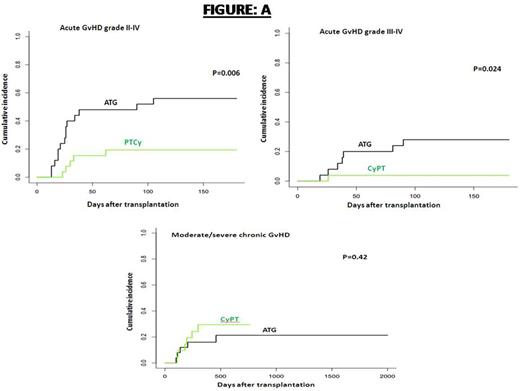Abstract
INTRODUCTION
Post-transplant high-dose cyclophosphamide (PTCy) has shown to prevent graft versus host disease (GvHD) after haploidentical allogeneic hematopoietic cell transplantation (HSCT). Although less extended, its use after matched unrelated donor (MUD) HSCT in combination with additional immunosuppression has been encouraging. The aim of this study was to analyze and compare outcomes of antithymocyte globulin based (ATG) versus PTCy-based GvHD prophylaxis in matched unrelated donor HSCT.
MATERIAL AND METHODS
We retrospectively analyzed 51 MUD (8/8 HLA-matched) transplants performed in two Spanish centers: 25 received ATG-based prophylaxis and were performed from 2010 to 2013, and 26 received PTCy-based prophylaxis and were performed from 2013 to 2016.
RESULTS
Characteristics of patients and post-HSCT complications are detailed in Table 1. There were no significant differences in age, gender, diagnosis and Disease risk index. For the ATG group, conditioning regimen consisted of fludarabine combined with busulfan (80%) or melphalan (12%), and TBI plus cyclophosphamide (8%). All patients received ATG 2 mg/kg from day -4 to day -2 followed by methotrexate and cyclosporine (CsA). Conditioning regimen for patients from the PTCy group consisted of fludarabine and busulfan (85%) and thiotepa combined with busulfan and fludarabine (15%). GvHD prophylaxis consisted of PTCy 50 mg/kg on days +3 and +4, combined with: CsA plus MMF in 57%, CsA alone in 31%, or tacrolimus plus MMF or sirolimus in 8%, and tacrolimus alone in 4%.
With a median follow-up of 58 months for the ATG group and 12 months for the PTCy group, there were no statistically significant differences in overall survival at 18 months (56% vs 85%, p=0.08), in event free survival (56% vs 68%, p=0.5), and in cumulative incidence of relapse (12% vs 18%, p=0.3). Non-relapse mortality at 12 months was significantly higher in the ATG group (32% vs 10%, p = 0.04). The ATG group presented more cases of hepatic toxicity grades I-IV and hemorrhagic cystitis than PTCy group (Table 1). Cumulative incidence of acute GvHD grades II-IV was higher in the ATG group as well as acute GvHD grades III-IV, with no differences in moderate/severe chronic GvHD incidence (Figure A).
CONCLUSION
In our experience, albeit differences in follow-up and limited number of patients, we conclude that PTCy combined with additional immunosuppression after MUD allogeneic HSCT offers lower rates of acute GvHD together with less toxicity and non-relapse mortality compared to ATG-based prophylaxis. Further analysis including larger series and follow-up are needed to confirm these observations.
No relevant conflicts of interest to declare.
Author notes
Asterisk with author names denotes non-ASH members.



This feature is available to Subscribers Only
Sign In or Create an Account Close Modal